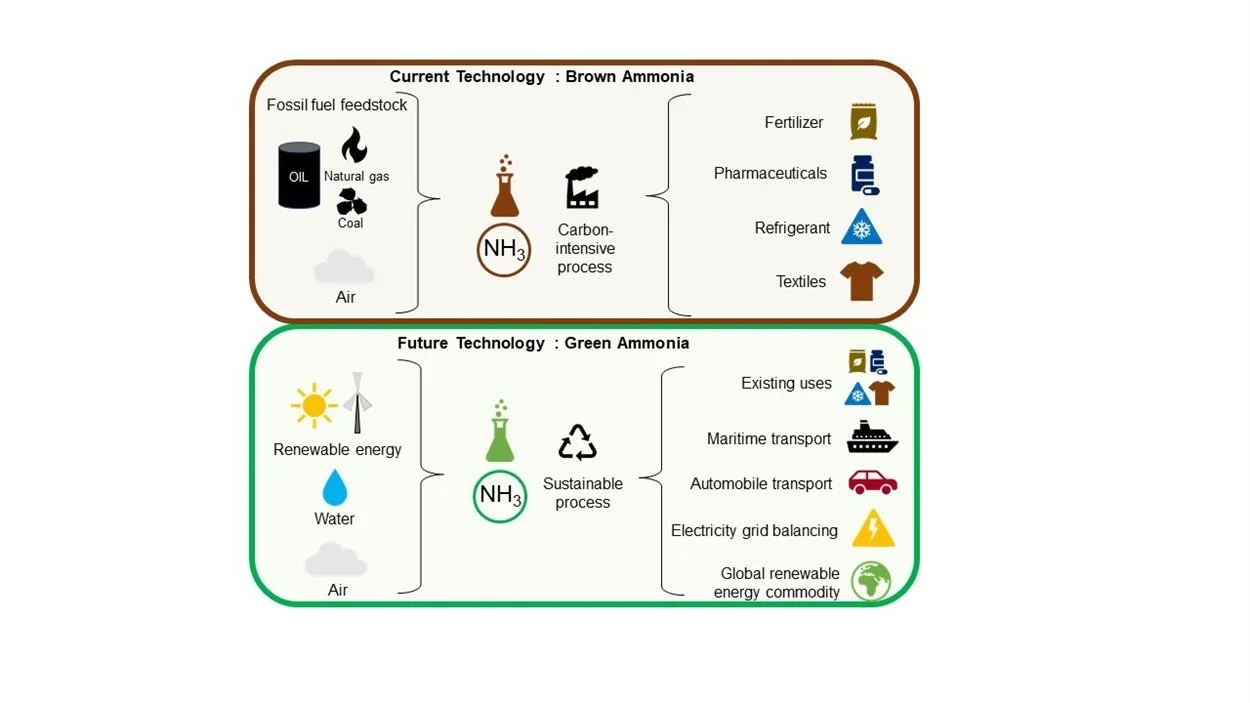Green Ammonia for Fertiliser
The most immediate application for Green ammonia is to replace the fossil fuel based ammonia that’s used for making almost all nitrogenous fertiliser worldwide. 175 million tonnes of ‘brown’ ammonia are produced in this way, mostly for fertiliser manufacture, causing nearly 2% of global greenhouse gas emissions.
Out with the Brown,
in with the Green!
The overwhelming bulk of the world’s nitrate fertiliser production is made from ‘brown’ ammonia, produced by burning fossil fuels - mostly natural gas, but some coal is also used. This ‘brown’ ammonia can be replaced with Green ammonia, which is functionally identical.
This means that Green ammonia producers have an existing market for their product, as they displace ‘brown’ ammonia as a primary fertiliser feedstock.
And fertiliser companies are keen to secure supplies of Green ammonia, so they can offer sustainable products with ultra-low carbon footprints. They in turn have eager customers for low carbon nitrogenous fertiliser, as they seek to drive down their carbon footprints. Thus the Norwegian hydropower and fertiliser giant Yara reports on its website:
“This year, Yara will introduce fossil-free, green fertilizers that are produced using renewable electricity instead of fossil fuels. These fertilizers will be predominantly made from water and air, resulting in an 80-90 percent reduction in carbon emissions compared to fertilizers made with natural gas.”
Fertilizers Europe states: “By 2050 - under the right conditions - ammonia production could be based on decarbonised sources of energy … A combination of policy solutions is needed to enable the transition to a climate-neutral economy by 2050 while keeping fertilizer industry competitive.”
Photo: The Yara / ENGIE Green hydrogen / ammonia demonstration project at Pilbara in Western Australia, targeted at zero-carbon Green fertiliser manufacture. Credit: ARENA.
Image: Sustainable fertiliser will be the first major global market for Green ammonia. Credit: Manoj Ravi et al.
Decentralised Green Ammonia
Until now almost all nitrogen fertiliser production has been carried on a large scale, based on ammonia synthesis using the Haber process. The industry began using abundant hydroelectricity from dams in Norway, but has shifted to using natural gas (mainly methane) as the source of both energy and hydrogen. Both of these methods achieve low cost through very large scale production.
However new technologies for ammonia synthesis based on wind and solar energy mean that small-scale production for local use is now viable in some locations. Benefits include security of supply, competitive production cost, absence of transport / distribution costs, and immunity to unpredictable price fluctuations on global markets.
Numerous US farmers now use wind turbines and / or solar panels to power hydrogen electrolysis and small ammonia production units. An alternative approach is to use high temperature plasma conditions to create oxides of nitrogen in solution, that might be chemically reduced to ammonia or applied directly to soils in aqueous solution.
The ammonia may be used as fertiliser by direct application to fields as an aqueous solution, and to fuel tractors and other agricultural equipment. See for example the Solar Hydrogen System developed by David Toyne, who farms 1,500 acres in Iowa (see photo). His approach is to synthesise ammonia in a high temperature, high pressure compressor.
This kind of decentralised, input-free nitrogen fertiliser production is of particular value in Africa, Asia and the Americas, where poor transport infrastructure, over-extended supply chains and high prices can lead to ‘nitrogen deficit’ in many far flung regions.
The recently opened talusOne plant in Kenya (see photo), based on Toyne’s technology, will surely be the first of many: the company’s ultimate aim is to reach all the 33 million small-scale farmers across sub-Saharan Africa that grow 80% of the region’s food.
Photo: The talusOne Green ammonia plant in Kenya, based on the Solar Hydrogen System developed by farmer David Toyne in Iowa, is now producing sustainable fertiliser in association with the Kenya Nut Company. Credit: David Toyne.
Image: Talus’s Green ammonia plant is modular and replicable on demand anywhere in the world with air, water and sunshine! Credit: Talus Renewables.
See our page on Green Ammonia Production for further information.




